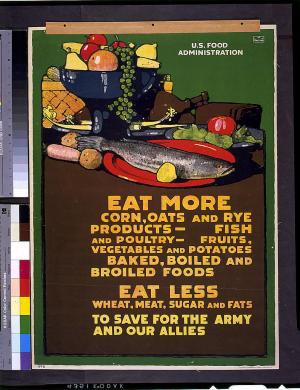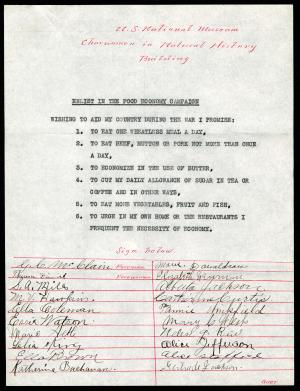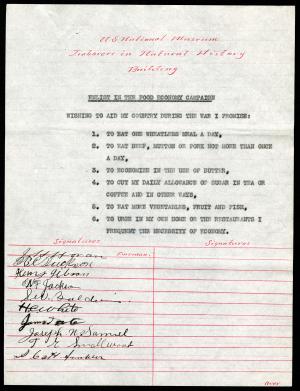![Save [...] and serve the cause of freedom, 1917, by Frederic G. Cooper, U. S. Food Administration, World War I Posters, Library of Congress, LC-USZC4-9740. Save [...] and serve the cause of freedom, 1917, by Frederic G. Cooper, U. S. Food Administration, W](https://siarchives.si.edu/sites/default/files/styles/body-image-300/public/blog-attached-images/3g09740v.jpg?itok=KbZKw8-1)
One of the best things about working in any archive is finding all sorts of things you weren’t looking for. Finding that letter or memo that you didn’t know about but gives you a new understanding of what was happening is one of the many reasons why people continue to go back to original documents time and time again.

I was lucky enough to have this happen to me just the other day. I’m working on a project around the Smithsonian’s activities during the world wars and as I was reading correspondence between the curators and the administration of the United States National Museum, I found a sheaf of documents that led me to new people and a new way World War I had an impact on the Smithsonian Institution and its staff. I found a stack of pledge sheets where Smithsonian employees were signing up to support the initiatives of the U. S. Food Administration. The U. S. Food Administration was a government agency set up during World War I to promote the conservation of foods that were in short supply and needed for soldiers abroad. Their efforts included the invention of meatless Mondays, which many of us may now recognize from current healthy eating initiatives. Meatless Mondays were accompanied by wheatless Wednesdays and efforts to reduce the consumption of dairy and fats.

Employees from across all branches of the Smithsonian pledged to follow the U. S. Food Administration recommendations. The most exciting part of finding these pledge sheets are the less visible Smithsonian employees they capture. Hidden among the curators, aids, and administrators who pledged are the charwomen and laborers of the Smithsonian. Often unrecorded in documents that have survived the test of time, these few pages show that everyone at the Smithsonian was doing their part for the war effort. They also are one of the few places we can learn more about the employees of the Smithsonian who are often forgotten. Looking at their signatures, you can not only get a sense of their personality, but see a place where they wrote themselves into the historical record with their own hand.

With a little sleuthing, these signatures can even tell us a little bit more about them. By looking for these men and women in the U. S. Census records and old Washington City Directories, I was able to find who some of these people were. Joseph N. Samuels, a laborer in the Natural History Building, would have been 30 at the time he signed this pledge. The 1915 Boyd’s City Directory for Washington, D.C., identifies him as a Laborer at the National Museum and tells us he lives in a house at 4432 Kane Place, NE, in Anacostia. Alberta Jackson, a charwoman in the Natural History Building, is recorded in the 1920 census as a ‘roomer,’ just three years after she signed her pledge. Forty four years old, black, and widowed at the time of the census, she was born in D.C. Her coworker Marie Donaldson signed the pledge just after Alberta and probably lived a similar life. In a 1924 City Directory she is recorded as a renter at 630 Morton Place, NE. This directory lists her as a forewoman at the National Museum, likely a promotion from her position as a charwoman in 1917.

While these may only be bits and pieces of a few peoples’ lives, they are clues to who these often forgotten employees were and how they contributed to the nation’s war effort and to the Smithsonian, making it what it is today.
Related Collections
- Record Unit 45 - Office of the Secretary, Records, 1890-1929, Smithsonian Institution Archives
- Census Records, National Archives and Records Administration
Related Resources
- U. S. Food Administration, Wikipedia
Produced by the Smithsonian Institution Archives. For copyright questions, please see the Terms of Use.

Leave a Comment